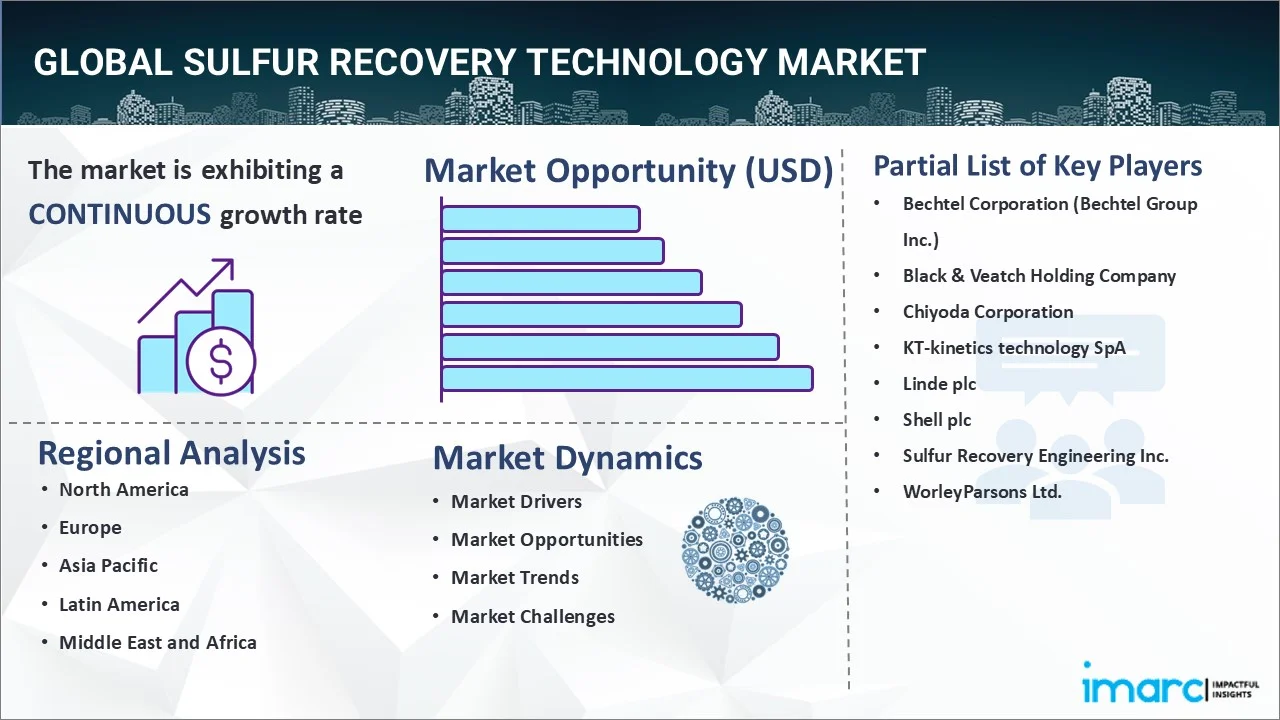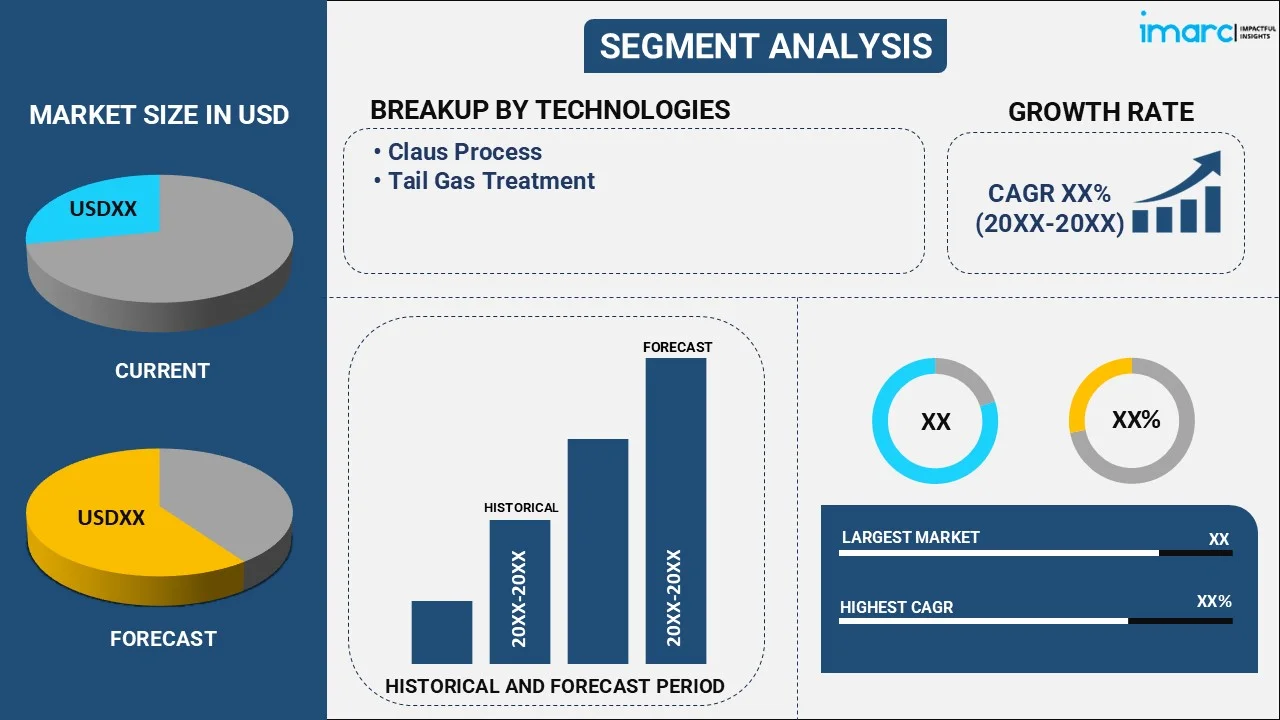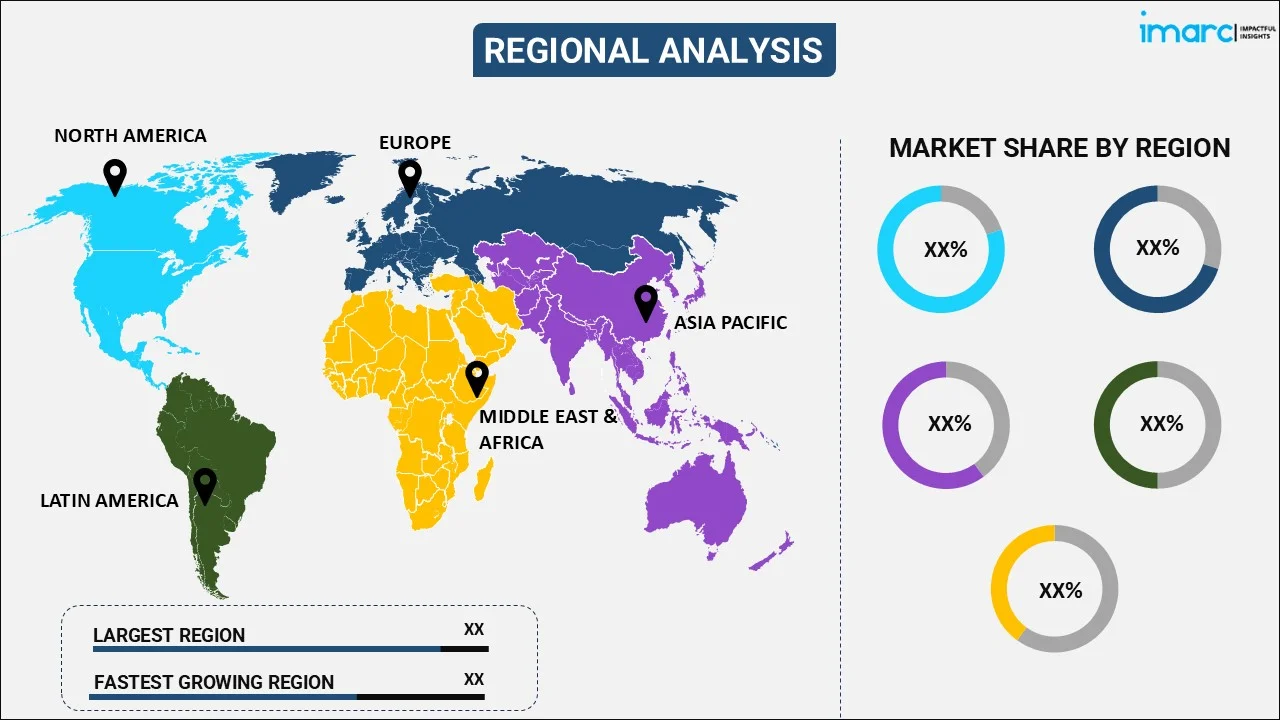
Sulfur Recovery Technology Market Report by Technology (Claus Process, Tail Gas Treatment), Source (Oil, Gas, and Others), and Region 2025-2033
Market Overview:
The global sulfur recovery technology market size reached USD 1.5 Billion in 2024. Looking forward, IMARC Group expects the market to reach USD 3.1 Billion by 2033, exhibiting a growth rate (CAGR) of 8.08% during 2025-2033. The implementation of stringent environmental regulations, rising growth in the oil and gas industry, rapid technological advancements, increasing demand for cleaner fuels, growing emphasis on reducing air pollution, and the heightened investments in refinery upgrades represent some of the major factors propelling the market.
|
Report Attribute
|
Key Statistics
|
|---|---|
|
Base Year
|
2024 |
|
Forecast Years
|
2025-2033
|
|
Historical Years
|
2019-2024
|
| Market Size in 2024 | USD 1.5 Billion |
| Market Forecast in 2033 | USD 3.1 Billion |
| Market Growth Rate (2025-2033) | 8.08% |
Sulfur recovery technology (SRT) refers to a technological process employed to extract sulfur from hydrogen sulfide-rich gases. It is instrumental in reducing harmful sulfur emissions and producing valuable sulfur products. Sulfur recovery technology includes various components like sulfur condensers, catalytic reactors, and reheat exchangers. It finds extensive use across diverse applications, such as petroleum refining, natural gas processing, agricultural fertilizers, paper and pulp industry, metallurgical ore processing, chemical synthesis, and pharmaceutical production. Sulfur recovery technology aids in ensuring environmental compliance, facilitating the production of elemental sulfur, providing energy efficiency, and improving product quality.

The increasing demand for cleaner fuels, necessitating the need for removing sulfur from fossil fuels, is one of the major factors boosting the market growth. Moreover, the growing application of SRT, as it enables the production of valuable by-products like sulfuric acid and elemental sulfur for various industries, is creating a positive outlook for the market growth. Additionally, the rising technology adoption due to their energy efficiency, which offers long-term cost savings for industrial operations, is supporting the market growth. Besides this, the growing emphasis on reducing air pollution, encouraging industries to adopt SRT to comply with environmental standards, and improving air quality is favoring the market growth. Along with this, the heightened investments in refinery upgrades to meet emission standards, prompting the adoption of advanced sulfur recovery technology, is bolstering the market growth.
Sulfur Recovery Technology Market Trends/Drivers:
Implementation of stringent environmental regulations
The implementation of stringent environmental regulations by governments to limit sulfur emissions is one of the major factors favoring the market growth. In line with this, the increasing focus on reducing environmental pollution, particularly air pollution caused by industrial activities, is creating a positive outlook for the market growth. Additionally, the introduction of various laws mandating the reduction of sulfur emissions from industrial plants is providing a thrust to the market growth. In addition to this, the rising enforcement of various regulations that include heavy fines and sanctions for non-compliance is providing an impetus to the market growth. In addition to this, the growing environmental regulations necessitating continuous improvements and upgrades in sulfur recovery technology are creating a positive outlook for the market growth. Along with this, the increasing demand for newer, more efficient sulfur recovery technology solutions, spurring innovation and development, is providing remunerative growth opportunities for the market.
Rising growth in the oil and gas industry
The widespread expansion of the oil and gas sector is one of the major factors contributing to the market growth. Moreover, the rising utilization of sulfur recovery technology due to the high sulfur content in many crude oil and natural gas reserves is providing a considerable boost to the market growth. In addition to this, the increasing demand for energy, leading to the exploration, extraction, and processing of fossil fuels, is anticipated to drive the market growth. Additionally, the growing application of sulfur recovery technology in refineries and natural gas processing plants to treat the sulfur in fossil fuels to meet product specifications and environmental standards is creating a positive outlook for the market growth. Along with this, the exploration of new oil and gas fields, particularly those with high sulfur content, is opening new opportunities for the market growth.
Rapid technological advancements
The rapid technological advancements in sulfur recovery technology leading to efficiency, cost-effectiveness, and environmental compliance are creating a positive outlook for the market growth. Moreover, the growing advancements, including improvements in the Claus process, leading to the development of more effective catalytic converters, and the integration of new materials and techniques in system design are fostering the market growth. In addition to this, the increasing development in catalytic conversion technologies, enhancing the conversion of hydrogen sulfide (H2S) to sulfur, and reducing the emission of sulfur compounds into the environment is positively impacting the market growth. Along with this, the rising utilization of new catalysts and reactor designs to improve the efficiency and reliability of the processes is providing a thrust to the market growth.
Sulfur Recovery Technology Industry Segmentation:
IMARC Group provides an analysis of the key trends in each segment of the market, along with forecasts at the global, regional, and country levels for 2025-2033. Our report has categorized the market based on technology and source.
Breakup by Technology:

- Claus Process
- Tail Gas Treatment
Claus process accounts for the majority of the market share
The report has provided a detailed breakup and analysis of the market based on the technology. This includes Claus process and tail gas treatment. According to the report, Claus process represented the largest segment.
The Claus process is dominating the market due to its efficiency in recovering sulfur from gaseous hydrogen sulfide. Moreover, it is versatile and can be used in various industries, such as natural gas processing and refining, where hydrogen sulfide is a common byproduct. Along with this, the Claus process helps in reducing sulfur emissions, thereby aiding in compliance with environmental standards. In addition to this, it is economically viable, especially at larger scales, making it a preferred choice for many industrial applications. Apart from this, rapid modifications and improvements in the process, such as the addition of tail gas treatment units to enhance the sulfur recovery rate and efficiency, are positively impacting the market growth.
Breakup by Source:
- Oil
- Gas
- Others
Oil holds the largest share in the industry
A detailed breakup and analysis of the market based on the source has also been provided in the report. This includes oil, gas, and others. According to the report, oil accounted for the largest market share.
Oil is dominating the market as it contains sulfur compounds, which vary in concentration depending on the source. Moreover, the refining process generates by-products rich in sulfur, such as hydrogen sulfide (H2S), necessitating effective sulfur recovery technologies to handle these emissions. Additionally, the increasing demand for sulfur recovery technology, as oil is one of the primary energy sources, is creating a positive outlook for the market growth. In addition to this, the implementation of stringent environmental regulations across the globe, mandating the reduction of sulfur emissions, is providing a thrust to the market growth. In line with this, sulfur recovery technology helps in achieving regulatory compliance and allows the recovery of sulfur as a valuable by-product from oil, which can be used in various industrial applications.
Breakup by Region:

- North America
- United States
- Canada
- Europe
- Germany
- France
- United Kingdom
- Italy
- Spain
- Others
- Asia Pacific
- China
- Japan
- India
- South Korea
- Australia
- Indonesia
- Others
- Latin America
- Brazil
- Mexico
- Others
- Middle East and Africa
Asia Pacific leads the market, accounting for the largest sulfur recovery technology market share
The market research report has also provided a comprehensive analysis of all the major regional markets, which include North America (the United States and Canada); Europe (Germany, France, the United Kingdom, Italy, Spain, and others); Asia Pacific (China, Japan, India, South Korea, Australia, Indonesia, and others); Latin America (Brazil, Mexico, and others); and the Middle East and Africa. According to the report, Asia Pacific accounted for the largest market share.
Asia Pacific is dominating the market due to the rising demand for energy, which necessitates the processing of large volumes of oil and natural gas, inherently involving the removal of sulfur. Moreover, the region is witnessing a substantial expansion in the oil and gas sector, with new refineries and processing plants being established to cater to the growing energy needs. Additionally, the rising environmental awareness and implementation of various regulations in the Asia Pacific region, prompting tougher standards for air quality and emissions control, is providing a thrust to the market growth. In line with this, the widespread adoption of sulfur recovery technology by manufacturers to comply with the regulations and minimize environmental impact is offering remunerative growth opportunities for the market.
Competitive Landscape:
The leading companies are heavily investing in research and development (R&D) to develop more efficient and cost-effective sulfur recovery technologies. It includes innovations in the Claus process, advancements in tail gas treatment methods, and the exploration of new catalysts and materials that can improve recovery rates and reduce operational costs. Moreover, the key companies are expanding their geographical reach and diversifying their service. Along with this, they are entering into collaborations with other companies, research institutions, and technology providers to combine expertise, share risks and costs, and accelerate the development of new technologies. Besides this, several players are focusing on providing customized solutions that involve designing sulfur recovery systems that cater to specific requirements of refineries, gas processing plants, and other industrial facilities.
The market research report has provided a comprehensive analysis of the competitive landscape. Detailed profiles of all major companies have also been provided. Some of the key players in the market include:
- Bechtel Corporation (Bechtel Group Inc.)
- Black & Veatch Holding Company
- Chiyoda Corporation
- KT-kinetics technology SpA
- Linde plc
- Shell plc
- Sulfur Recovery Engineering Inc.
- WorleyParsons Ltd.
(Please note that this is only a partial list of the key players, and the complete list is provided in the report.)
Sulfur Recovery Technology Market Report Scope:
| Report Features | Details |
|---|---|
| Base Year of the Analysis | 2024 |
| Historical Period | 2019-2024 |
| Forecast Period | 2025-2033 |
| Units | Billion USD |
| Scope of the Report | Exploration of Historical and Forecast Trends, Industry Catalysts and Challenges, Segment-Wise Historical and Predictive Market Assessment:
|
| Technologies Covered | Claus Process, Tail Gas Treatment |
| Sources Covered | Oil, Gas, Others |
| Regions Covered | Asia Pacific, Europe, North America, Latin America, Middle East and Africa |
| Countries Covered | United States, Canada, Germany, France, United Kingdom, Italy, Spain, China, Japan, India, South Korea, Australia, Indonesia, Brazil, Mexico |
| Companies Covered | Bechtel Corporation (Bechtel Group Inc.), Black & Veatch Holding Company, Chiyoda Corporation, KT-kinetics technology SpA, Linde plc, Shell plc, Sulfur Recovery Engineering Inc., WorleyParsons Ltd., etc. |
| Customization Scope | 10% Free Customization |
| Post-Sale Analyst Support | 10-12 Weeks |
| Delivery Format | PDF and Excel through Email (We can also provide the editable version of the report in PPT/Word format on special request) |
Key Questions Answered in This Report:
- How has the global sulfur recovery technology market performed so far, and how will it perform in the coming years?
- What are the drivers, restraints, and opportunities in the global sulfur recovery technology market?
- What is the impact of each driver, restraint, and opportunity on the global sulfur recovery technology market?
- What are the key regional markets?
- Which countries represent the most attractive sulfur recovery technology market?
- What is the breakup of the market based on technology?
- Which is the most attractive technology in the sulfur recovery technology market?
- What is the breakup of the market based on the source?
- Which is the most attractive source in the sulfur recovery technology market?
- What is the competitive structure of the global sulfur recovery technology market?
- Who are the key players/companies in the global sulfur recovery technology market?
Key Benefits for Stakeholders:
- IMARC’s industry report offers a comprehensive quantitative analysis of various market segments, historical and current market trends, market forecasts, and dynamics of the sulfur recovery technology market from 2019-2033.
- The research report provides the latest information on the market drivers, challenges, and opportunities in the global sulfur recovery technology market.
- The study maps the leading, as well as the fastest-growing, regional markets. It further enables stakeholders to identify the key country-level markets within each region.
- Porter's five forces analysis assist stakeholders in assessing the impact of new entrants, competitive rivalry, supplier power, buyer power, and the threat of substitution. It helps stakeholders to analyze the level of competition within the sulfur recovery technology industry and its attractiveness.
- Competitive landscape allows stakeholders to understand their competitive environment and provides an insight into the current positions of key players in the market.
Need more help?
- Speak to our experienced analysts for insights on the current market scenarios.
- Include additional segments and countries to customize the report as per your requirement.
- Gain an unparalleled competitive advantage in your domain by understanding how to utilize the report and positively impacting your operations and revenue.
- For further assistance, please connect with our analysts.
 Inquire Before Buying
Inquire Before Buying
 Speak to an Analyst
Speak to an Analyst
 Request Brochure
Request Brochure
 Request Customization
Request Customization




.webp)




.webp)












